Sitting in the liver. Why removal of liver tumors is an indicator of the surgeon’s superior skill
As part of the materials on the treatment of cancer, we have not yet touched on such a crucial area in our blog as surgery. Although surgical removal of the tumor is the only radical treatment method that exists in oncology.
A radical method is one that eliminates the main problem and the cause of all other severe symptoms: malignant neoplasm.
“Medicine 24/7” , first of all, is a surgical hospital with a serious load: among private clinics in Moscow, ours is in first place in the consumption of blood and blood components that are needed during operations.
Surgery on the liver is not the most important and popular area of the clinic. However, the fact that, in principle, such manipulations are performed in our hospital, rather than sending patients to somewhere else, is a marker and an indicator of the highest qualification of the surgeon team.
Surgery on the liver is equivalent to surgery on the brain and open heart. As a rule, this is the seventh category of complexity out of 7 possible.
At the same time, successful surgical treatment of malignant neoplasms in the liver allows one to count on prolonging the patient’s life: five-year survival of 40-50% with primary liver cancer or single metastases is a good result.
We often get patients who were not operated on in other clinics for one or another official reason. But people want to take a second chance, and we give it to them.
In this article we will try to explain why it is the liver that so often requires attention in the treatment of cancer, why not every surgeon risks operating it and are there any alternatives to the scalpel.
The liver is an amazingly multitasking organ . Her work can be divided into 3 areas.
1. Deposit. The body stores many necessary things in the liver: energy reserves in the form of glycogen; some vitamins (A, D, B12, K, PP); trace elements (the main of which is iron).
Also, there is always a very significant amount of blood. If in the body as a result of trauma an opening not provided for by nature is formed, then this blood reserve will be urgently thrown into the main bloodstream and for a while will compensate for blood loss.
2. Synthesis. This body is a “factory” of important hormones, enzymes. Many plasma proteins, including those due to which blood coagulates when necessary, but does not stick together in blood clots in ordinary life, are formed here. But most importantly, the liver produces bile, a component of healthy digestion.
3. Detox. The liver is unique in that it can neutralize poisons, toxins, allergens and other dangerous substances that enter the body from the outside, as well as arising as a product of our metabolism.
All these important functions of the liver are provided by its special blood supply system.
About 1.5 liters of blood pass through the liver per minute. About a quarter of this volume enters the hepatic artery, the remaining 75% - through the portal vein from the intestine.
Inside the liver there are sinusoids - special capillaries in which arterial blood mixes with venous and this mixture is already “filtered” by hepatocytes (cells of the liver tissue): useful and nutrients are stored, toxins are neutralized as a result of complex chemical reactions. Then, the blood that went through all the stages of the “treatment” enters the hepatic vein and returns to the heart.
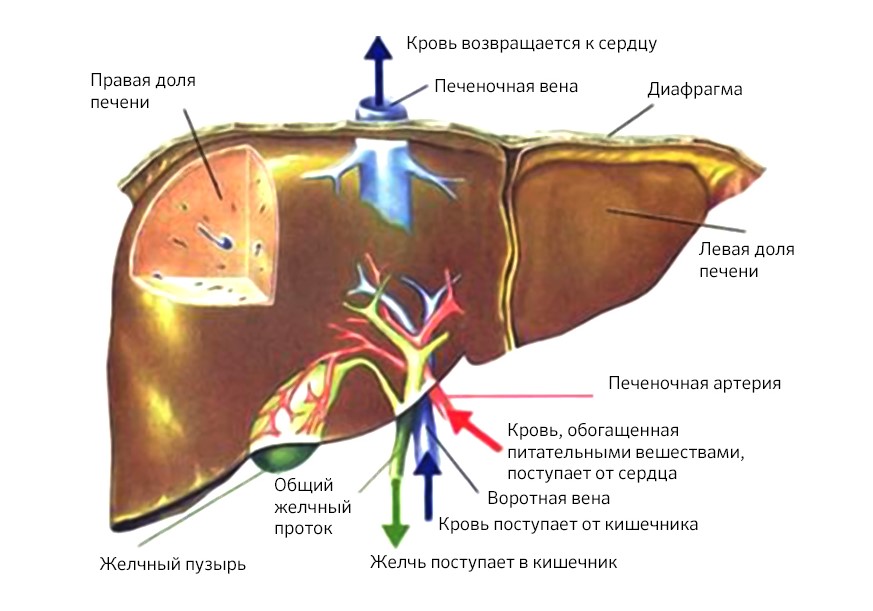
The circulatory system in the liver
But this same wonderful system, which allows the liver to filter 2,000 liters of blood per day, also contributes to the spread of cancer cells. They are carried through the body through the bloodstream, and the liver, which lets in and holds out all the excess in itself, thus becomes a target for metastases.
According to statistics, the primary liver tumor - hepatocellular cancer - is less common than metastases in this organ from other malignant neoplasms. The total number of patients with liver metastases in Russia is more than 100,000 - many times more than patients with primary tumors of the liver and intrahepatic bile ducts (there are less than 15,000).
But almost all malignant neoplasms metastasize precisely to the liver. Colon cancer (colorectal cancer) does this in 50% of cases. In 30% of cases metastatic lesions occur with melanoma and breast cancer.
Our leading oncologist surgeon in this area, Anton Aleksandrovich Ivanov, gives one of the most interesting examples in his practice.
“A patient with liver cancer metastases in the liver. Usually such cases are not accepted to operate at all. But during the examination, we found out that the liver is the only organ that succumbed to metastasis. This was a rare success, and the surgeons made a collegial decision: to operate.
And when in preparation for the operation they did a biopsy of metastases, it turned out that the cancer cells in the liver mutated, and the initial HER2-negative tumor status changed, became HER2-positive, 3+. This means that the disease is sensitive to Herceptin, an effective remedy against this type of cancer. The patient had metastases removed, half of the liver was resected. More than 10 years have passed, she receives the drug and is still alive. When he comes for examinations, he complains not so much about well-being, but about hooligans-grandchildren. ”
Unfortunately, both liver cancer and metastases in it are often diagnosed in an already neglected state.
The reasons for this situation are the flip side of the "superpowers" of the body. The liver has a huge margin of safety: to cope with its duties, it is enough for it 15-20% of healthy parenchyma (liver tissue).
“Tumors themselves do not hurt, but simply use a resource of healthy tissues. So it turns out that a liver affected by a tumor may not give a signal at all until the disease affects more than half of the organ - and this is stage III-IV: 58% of primary liver tumors are detected in Russia in a state of a running process, ”explains Anton Alexandrovich .
In this case, ultrasound and even CT can miss a node in the liver, if it is still very small, and not in 100% of cases, such studies make it possible to understand the exact size, shape and nature of the focus.
This diagnostic difficulty can be overcome: using hepatotropic (i.e., acting on the liver) contrast agents for MRI. There are three of them, in Russia since 2007, one is allowed and recommended for use: Primovist. It is able to accumulate precisely in hepatocytes, but malignant tumors do not “absorb” it, due to this they become most clearly visible in the pictures.
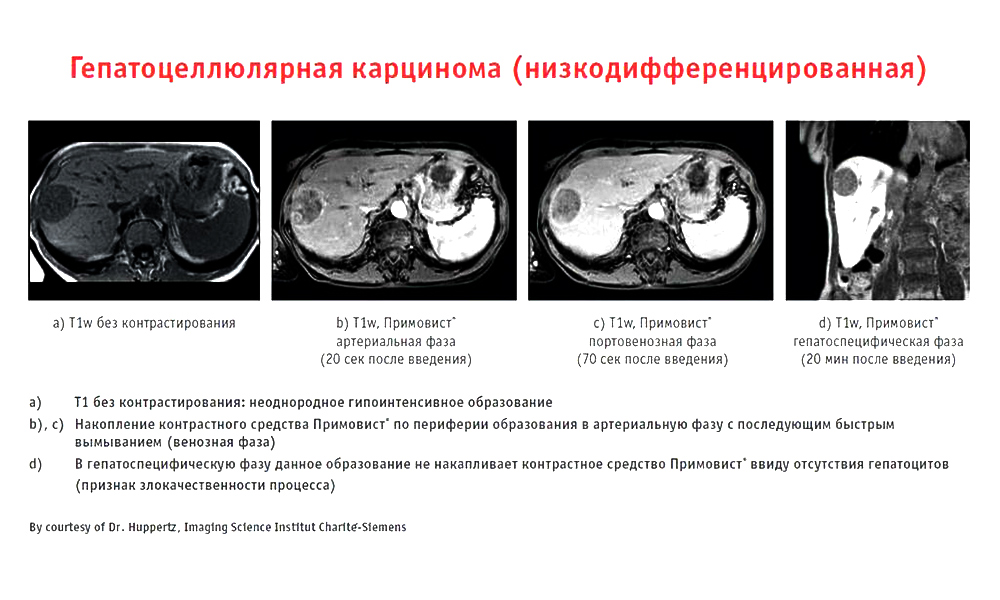
An example of the work of the contrast drug Primovist
Today this drug is the gold standard for MRI diagnostics of liver tumors, hepatologists in Medicine 24/7 use it without fail, which ensures the proper level of accuracy.
But, unfortunately, in many regions the situation is more complicated: to find clinics that know and use Primovist there is still difficult, like 10 years ago.
Even if a tumor site is found in the liver, not every doctor can remove it: it is more difficult for a surgeon to work in the hepatopancreatobiliary zone than to read the word “hepatopancreatobiliary” aloud the first time.
This zone includes the liver (Greek hepar), pancreas (lat. Pancreas), gall bladder (lat. Vesica biliaris) and bile ducts. All these organs are closely related anatomically and functionally.
Most interventions in other areas of surgery are performed on one small specific location, and if we are talking about resection (removal of part) of the liver, then the amount of work is large, even when touching one or two segments.
It is difficult, firstly, purely technically.
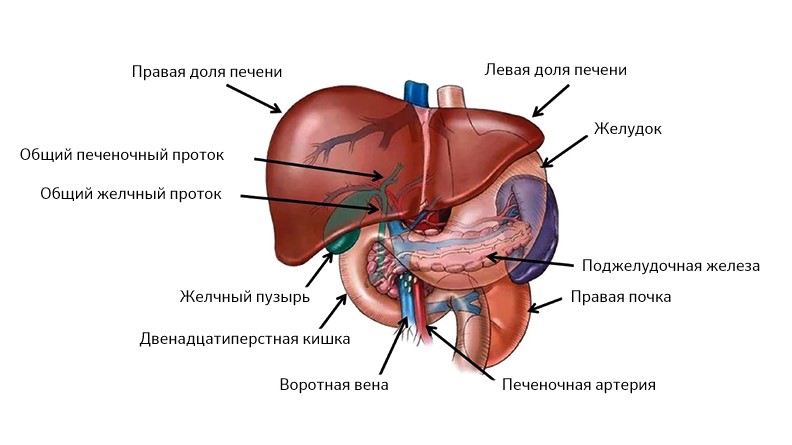
The liver is on the right side, the pancreas is on the left, all of their ducts are combined into one and enter the duodenum.
The liver is very complicated, it consists of segments and lobes, between which there are ligaments, they are all literally entangled and pierced by veins, arteries and bile ducts ducts.
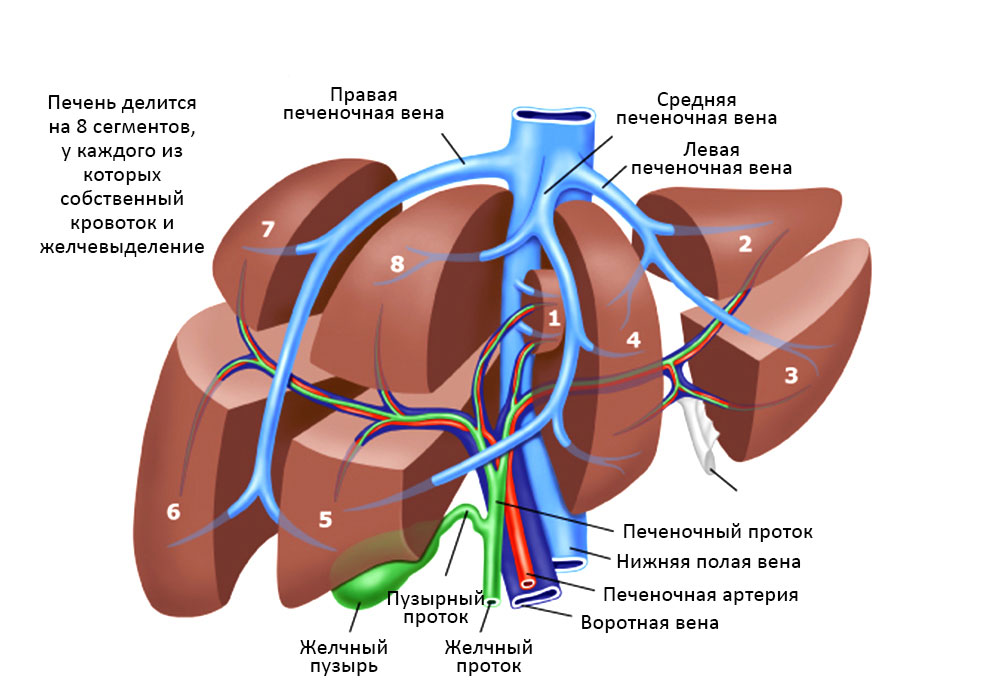
Relations between segments of the liver, bile ducts and blood vessels
There is a risk that a large vascular bundle is located in this area, everything happens very close to the inferior vena cava, the hepatic artery: these are large main vessels. The liver itself is bleeding heavily. Accordingly, there is a risk of serious blood loss, the operation should be both as quick and extremely accurate as possible.
Such an intervention should be carried out by a person with extensive experience in conducting these operations, and the expense of such specialists goes to units. We have two of them at Medicine 24/7 , and patients often come to them from colleagues from other (highly respected) medical institutions, where, nevertheless, there are no specialists with sufficient skills.
Both the doctor and the patient are carefully preparing for liver operations, so that everything goes as predictably as possible. Anton Alexandrovich Ivanov explained in detail how the oncologist surgeon and his team are preparing for liver surgery, and that they are trying to provide for everything.
“In order to accurately determine the scope and method of intervention, all the necessary studies are carried out. The operation area is visualized with maximum accuracy. The results of many analyzes are taken into account. For example, with certain infectious diseases or a decrease in the number of platelets in the blood, the doctor will first select a therapy to restore normal values and only then will prescribe an operation.
Immediately at the time of the intervention in the operating room, in addition to the doctor, there is a whole team of specialists who monitor the patient's life: anesthetists, resuscitators, transfusiologists, and an operating nurse. Of course, today the doctor doesn’t even remove the tooth alone, but the largest team is assembled in the operating room for liver operations.
A supply of blood components — red blood cells, plasma — is guaranteed, so that they can be compensated for at any time with large blood loss. In our practice, we use a special device, Cell Saver, which from the blood lost by the patient immediately separates (separates) red blood cells and returns them back to his bloodstream. "Own" is always more favorable than "canned" donor red blood cells, even suitable for blood type. "
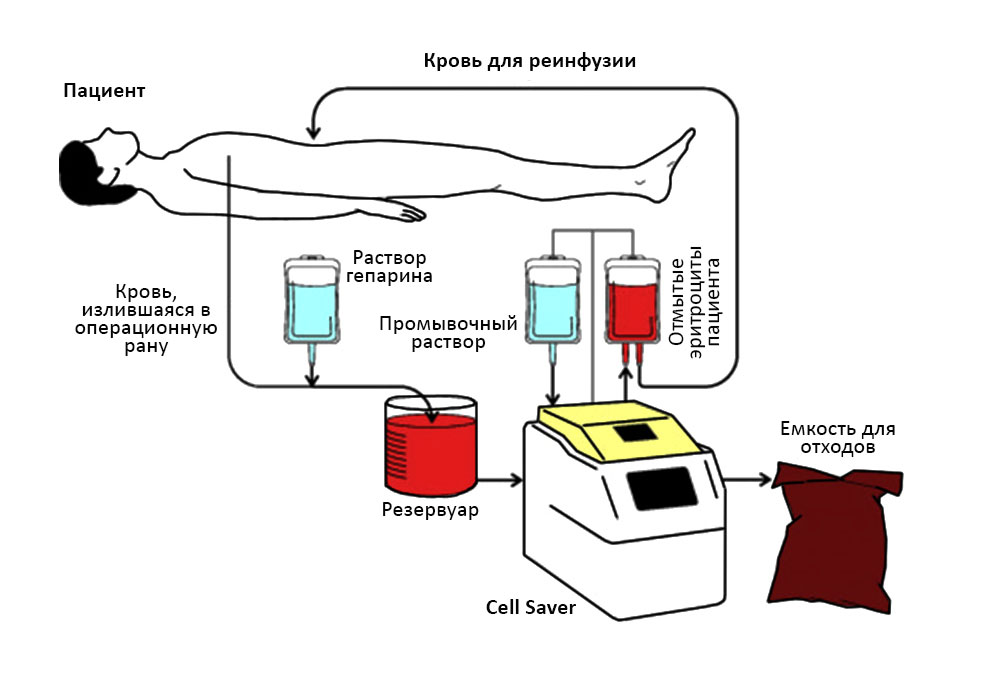
The patient’s blood enters the Cell Saver, and he returns the red blood cells to the patient.
Quite regularly, the operations are simultaneous (simultaneous): liver resection takes place simultaneously with other interventions. The primary lesion, for example, in the colon, and metastasis in the liver are also removed.
However, even with maximum predictability and complete control of the process, surgeons happen to deviate from the intended plan.
For example, during an operation for a primary tumor of the stomach, an accidental find may occur: a small single metastasis in the liver. In this case, surgeons can invite colleagues, specialists in liver operations, so that they carry out their stage: removal of a part of the liver.
Joint operations are good because the patient is subjected to anesthesia and the difficulties of the recovery period only once.
In time, the operation takes from 1.5 hours (with resection of a single metastasis) to 10-12. “In my practice, the longest operation with simultaneous removal of the primary lesion in the intestine and metastases in the liver lasted 15 hours,” Dr. Ivanov recalls, “but this is rather an exceptional case.”
Size matters. If the tumor is large, managed to “eat” too much healthy tissue, then removing it may be pointless. To ensure that the patient is guaranteed to undergo surgery, at least 30% should remain from the liver after removal of the part. With fibrosis, fatty hepatosis or cirrhosis (and they often accompany or precede liver cancer), this indicator increases to 35-40%, otherwise the remaining liver with these pathologies will not be able to function adequately.
Localization of foci and their number. If metastases are multiple and “scattered” across several segments, then removing them is inappropriate: statistics show that the survival rate for such operations does not improve.
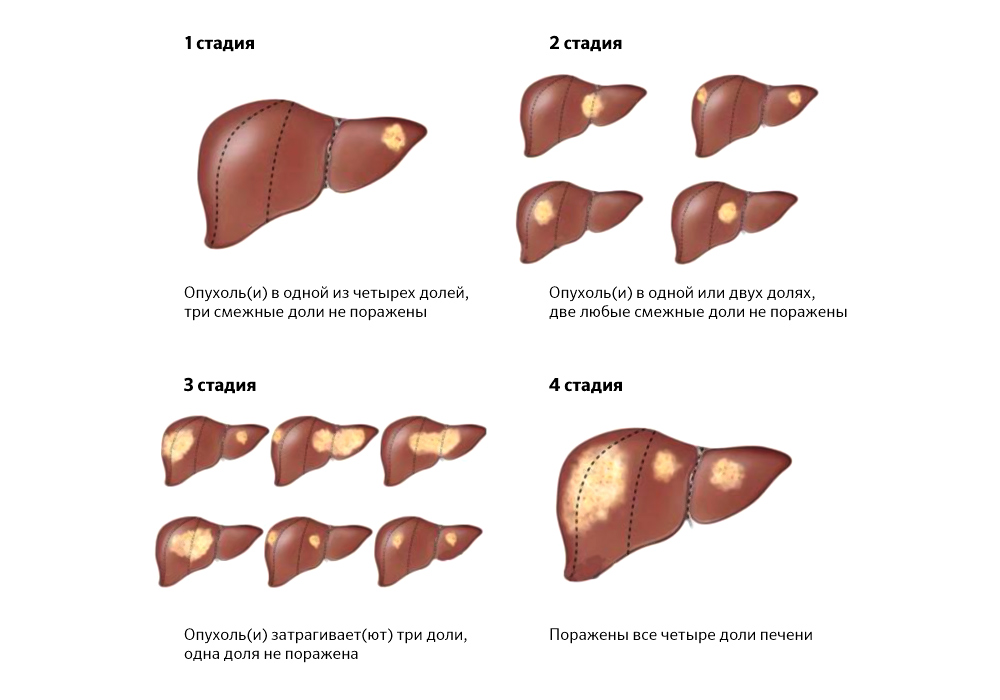
The prevalence of tumor lesions sometimes makes surgical treatment impossible
. Contraindications.These are the patient’s health conditions that make the success of the intended operation statistically minimal.
1. Peritoneal carcinomatosis (carcinomatosis is less common by ear, but medically more accurate term). Cancer cells from the primary lesion with blood and lymph flow: spread through the abdominal cavity and “sprout” in several organs at once.
2. Non-stopping ascites is the accumulation of a large amount of fluid in the abdominal cavity. In addition to the fact that this creates difficulties during surgery, ascites acts as a factor that provokes the spread of metastases. If it cannot be controlled, then it is highly likely that metastases quickly recur.
3. Mechanical jaundice. A tumor site, compressing the bile ducts, disrupts the outflow of bile and provokes the flow of bilirubin (the breakdown product of hemoglobin) into the blood. Accumulating, it stains the sclera (whites of the eyes), the skin and mucous membranes of the patient in yellow. This is dangerous: bilirubin is toxic and aggravates the patient's condition.
However, even for such patients who are not accessible to surgical interventions, treatment methods exist.
In cases where the patient was unable to remove the neoplasm in the liver by classical surgical means, there is interventional oncology and endovascular ("intravascular") surgery.
Hepatologists at 24/7 Medicine actively use them to increase survival rates. Like classical operations, these methods also have limitations, but thanks to them, many of our patients with unresectable liver tumors got a second chance to extend their life.
ChemoembolizationVascular supplying the tumor is the main endovascular treatment for liver cancer. A thin catheter inserted through the femoral artery moves directly into the vessel supplying the tumor tissue and delivers a preparation containing microcapsules from a special medical plastic into it. They mechanically block the blood flow, depriving tumor cells of nutrition, and secrete a medicine against tumor growth, and directly into the lesion and in high concentration.
This method is able to reduce the volume of the tumor in the liver, and, therefore, in some cases - to make possible one of the options for surgical resection.
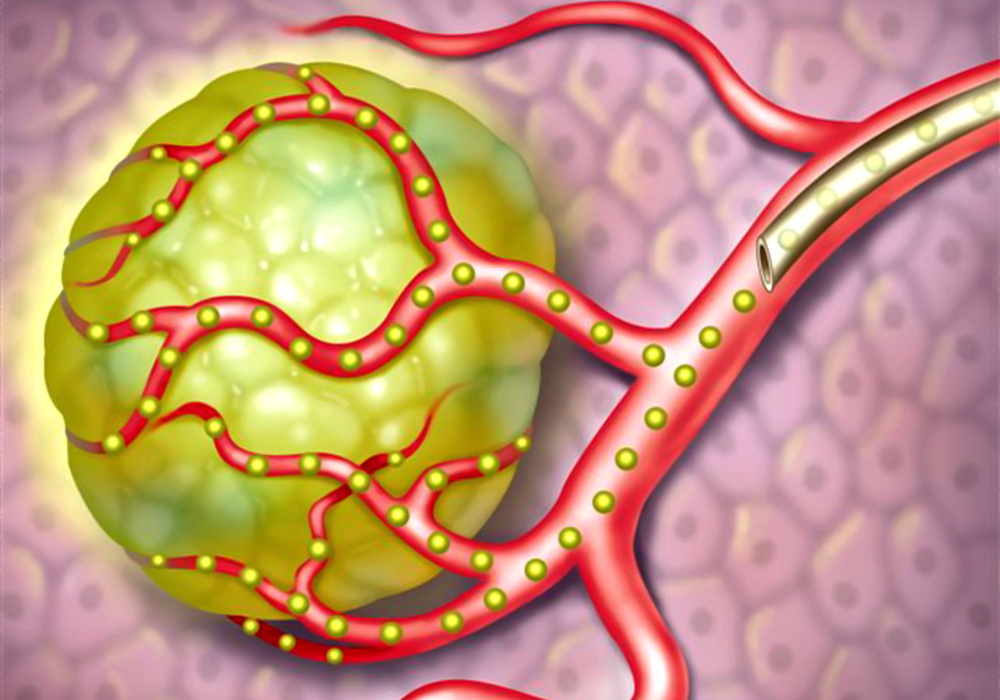
Scheme for the administration of emboli (microcapsules) through a catheter directly to the tumor
Radio-frequency ablation of the tumor.Through a puncture in the skin, a thin electrode is applied directly to the tumor site, at the end of which a radio frequency pulse creates a high temperature. And the surgeon precisely “burns out” the neoplasm.
Stenting. Installing a stent (dilator) into a bile duct or vessel squeezed by a tumor helps to overcome, for example, obstructive jaundice, to establish blood flow and outflow of bile - i.e. remove one of the main contraindications for surgical intervention.
These are the most popular methods in our clinic. In other cases, we use cryodestruction (destruction of the tumor at low temperatures), and HIPEC hyperthermic chemotherapy (against peritoneal carcinomatosis), and other suitable methods.
“The lack of competent surgeons is the most obvious difficulty that patients face,” said Anton Ivanov. - I have worked for 19 years in both public and private medicine, and everywhere there are enthusiastic doctors who do not have enough experience, who say: “We’ll cut it out now!”, They take the patient to the operating table, but they don’t carry out the operation to the extent which was needed, for example. Unfortunately, the prognosis of such patients does not improve after surgery. ”
There are doctors who honestly admit that they do not perform such operations, and sends the patient to large centers, to capitals. On the one hand, it is safer than a half-surgeon, on the other hand, it is extremely difficult for such a patient to get free treatment. Even in the CHI system, liver surgery is not part of the standard of medical care. This is a high-tech quota surgery.
In any case, the patient must remember, no matter how frightening the verdict is, it is necessary to get a second opinion: this is true not only in therapy, clinical oncology, but also in surgery.
In our “Medicine 24/7” surgeons and hepatologists, despite their impressive experience, each liver operation must be discussed collectively in order to make the most informed decision.
Price.For those who are not lucky to get a quota for a free operation, surgical treatment of liver tumors costs serious money. Within our private hospital, for example, the resection itself, plus being in the clinic, pre- and postoperative examinations, resuscitation, cost about 700,000 rubles.
Abroad, despite using the same technologies and the same risks, liver surgery for metastatic lesions costs 6 times more: from 60,000 euros.
Difficulties with transplantation. For each of the patients with unresectable tumors and the presence of contraindications to other interventions, ideally, there should always be the last chance: a liver transplant. But in Russia, transplantology is still lagging behind world experience.
Largely because of administrative problems. The legislation and the issuance of licenses for donor organ transplants are not fully regulated; a large waiting list, and the lists of needing transplants are not combined by region. In the EU, for example, the system of control of donor organs is centralized: a suitable liver that appears in one of the countries can be quickly brought to another country where it is urgently needed.
In addition, the problem is in the public consciousness. In Western Europe or the USA, the consent of, say, nieces to give part of the liver for transplantation to an uncle is a rather mundane plot. In our country, relatives refuse to become donors. Not all people know how successfully the liver is restored, from which part was taken, but not all surgeons are ready to risk two lives, not one.
Hope for bioengineering: judging by the current work in this direction, in 20 years, scientists will learn to "grow" artificial liver in the right quantities. We sincerely hope to catch this moment.
And while the bright minds of researchers come up with how to solve the problem of lack of donor material, the golden hands of our surgeons gain new experience.
The ALPPS (Associated Liver Partition and Portal vein ligation for Staged hepatectomy) technique, described and tested by German surgeons in 2012, expands the possibilities for the surgical treatment of liver tumors that were previously considered unresectable .
The meaning of this two-stage operation is not to immediately remove the part of the liver affected by the tumor, but to separate it from healthy tissue, to separate their blood flow and to make the patient two autonomous liver. After that, wait 6-8 days until the remaining “piece” of healthy tissue grows to a size sufficient to perform its functions, and completely remove the metastases of the affected part.
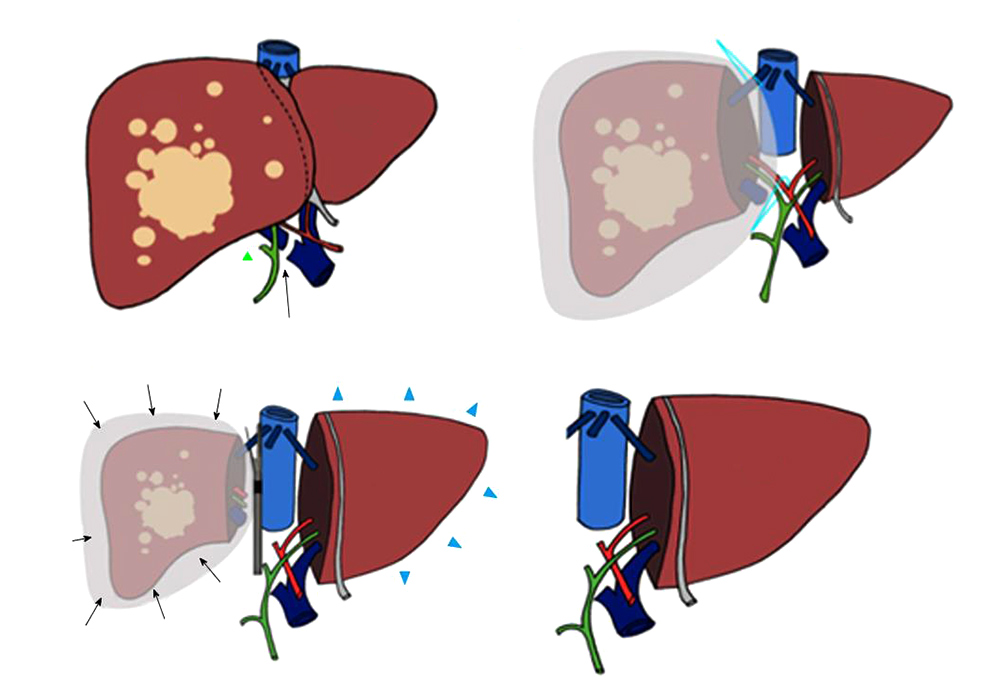
In a week, the left lobe of the liver grows to the size that allows it to work normally.
In Russia, ALPPS is not widely used so far, but the experience that our domestic colleagues already have shows as successful results as foreign surgeons.
The development of endoscopic surgery.Technical equipment is still developing rapidly. Now we can, using thin flexible micro-instruments introduced in two skin punctures, cure a person, remove an entire organ, etc. Surgeons can perform very complex manipulations that were not possible 20-30 years ago. The quality of the image from microscopic cameras during such operations improves every year.
The main thing is that you need enough motivation and desire from doctors to learn, master these technologies. And of course, serious money is needed to buy sophisticated equipment and train doctors. Both of these factors can rarely be combined in a medical institution, even if it is an advanced scientific institution. And among private clinics, we are the only ones who perform central resection of the liver
The obvious answer is "Do not abuse alcohol." Constant alcohol intoxication leads to hepatosis and cirrhosis of the liver: hepatocytes die, and the voids in their place are replaced by scar tissue. Over time, this can lead to liver failure, as well as liver cancer.
About 5% of hepatocellular carcinoma is associated with aflatoxin, an extremely toxic substance produced by fungi that parasitize on peanuts, sesame seeds, sunflower seeds, corn, rice and other crops. Residents of civilized countries encounter him infrequently, but he, nevertheless, is very dangerous if you eat products infected with such a fungus: poison irreversibly damages liver cells.
However, the most significant risk factor, according to statistics, more dangerous than alcohol, today is infection with viral hepatitis. Half a century ago, this was a problem in Asia and Africa, and today the incidence of hepatitis B and C in Europe and, in particular, in Russia, leads to an increase in the appearance of primary liver cancer. Moreover, it happens that hepatitis does not show symptoms, and people may not know for a long time that they are carriers of the virus.
Therefore, you should not neglect hepatitis B vaccines and annually check for hepatitis C - vaccines have not yet been invented from him.
Regularly checked is the fundamental basis for successful prevention, or at least early diagnosis (and, therefore, effective treatment).
“The earlier the tumor is detected, the greater the patient’s chances for successful radical treatment, surgically,” Dr. Ivanov recalls. - Therefore, every surgeon in Medicine 24/7 will tell you: the key to success is a medical examination. It can still be passed through the MLA. But since it no longer exists in the mandatory form, you should take care of your health voluntarily: do an ultrasound scan, give oncomarkers adequate for your age, find out a family history. ”
And choose nuts carefully. Just in case.
A radical method is one that eliminates the main problem and the cause of all other severe symptoms: malignant neoplasm.
“Medicine 24/7” , first of all, is a surgical hospital with a serious load: among private clinics in Moscow, ours is in first place in the consumption of blood and blood components that are needed during operations.
Surgery on the liver is not the most important and popular area of the clinic. However, the fact that, in principle, such manipulations are performed in our hospital, rather than sending patients to somewhere else, is a marker and an indicator of the highest qualification of the surgeon team.
Surgery on the liver is equivalent to surgery on the brain and open heart. As a rule, this is the seventh category of complexity out of 7 possible.
At the same time, successful surgical treatment of malignant neoplasms in the liver allows one to count on prolonging the patient’s life: five-year survival of 40-50% with primary liver cancer or single metastases is a good result.
We often get patients who were not operated on in other clinics for one or another official reason. But people want to take a second chance, and we give it to them.
In this article we will try to explain why it is the liver that so often requires attention in the treatment of cancer, why not every surgeon risks operating it and are there any alternatives to the scalpel.
Venue: Why Cancer Affects the Liver So Frequently
The liver is an amazingly multitasking organ . Her work can be divided into 3 areas.
1. Deposit. The body stores many necessary things in the liver: energy reserves in the form of glycogen; some vitamins (A, D, B12, K, PP); trace elements (the main of which is iron).
Also, there is always a very significant amount of blood. If in the body as a result of trauma an opening not provided for by nature is formed, then this blood reserve will be urgently thrown into the main bloodstream and for a while will compensate for blood loss.
2. Synthesis. This body is a “factory” of important hormones, enzymes. Many plasma proteins, including those due to which blood coagulates when necessary, but does not stick together in blood clots in ordinary life, are formed here. But most importantly, the liver produces bile, a component of healthy digestion.
3. Detox. The liver is unique in that it can neutralize poisons, toxins, allergens and other dangerous substances that enter the body from the outside, as well as arising as a product of our metabolism.
All these important functions of the liver are provided by its special blood supply system.
About 1.5 liters of blood pass through the liver per minute. About a quarter of this volume enters the hepatic artery, the remaining 75% - through the portal vein from the intestine.
Inside the liver there are sinusoids - special capillaries in which arterial blood mixes with venous and this mixture is already “filtered” by hepatocytes (cells of the liver tissue): useful and nutrients are stored, toxins are neutralized as a result of complex chemical reactions. Then, the blood that went through all the stages of the “treatment” enters the hepatic vein and returns to the heart.

The circulatory system in the liver
But this same wonderful system, which allows the liver to filter 2,000 liters of blood per day, also contributes to the spread of cancer cells. They are carried through the body through the bloodstream, and the liver, which lets in and holds out all the excess in itself, thus becomes a target for metastases.
Liver tumors: hard to find, easy to start, sometimes impossible to cut
According to statistics, the primary liver tumor - hepatocellular cancer - is less common than metastases in this organ from other malignant neoplasms. The total number of patients with liver metastases in Russia is more than 100,000 - many times more than patients with primary tumors of the liver and intrahepatic bile ducts (there are less than 15,000).
But almost all malignant neoplasms metastasize precisely to the liver. Colon cancer (colorectal cancer) does this in 50% of cases. In 30% of cases metastatic lesions occur with melanoma and breast cancer.
Our leading oncologist surgeon in this area, Anton Aleksandrovich Ivanov, gives one of the most interesting examples in his practice.
“A patient with liver cancer metastases in the liver. Usually such cases are not accepted to operate at all. But during the examination, we found out that the liver is the only organ that succumbed to metastasis. This was a rare success, and the surgeons made a collegial decision: to operate.
And when in preparation for the operation they did a biopsy of metastases, it turned out that the cancer cells in the liver mutated, and the initial HER2-negative tumor status changed, became HER2-positive, 3+. This means that the disease is sensitive to Herceptin, an effective remedy against this type of cancer. The patient had metastases removed, half of the liver was resected. More than 10 years have passed, she receives the drug and is still alive. When he comes for examinations, he complains not so much about well-being, but about hooligans-grandchildren. ”
Unfortunately, both liver cancer and metastases in it are often diagnosed in an already neglected state.
Sitting quietly: why do tumors in the liver detect too late
The reasons for this situation are the flip side of the "superpowers" of the body. The liver has a huge margin of safety: to cope with its duties, it is enough for it 15-20% of healthy parenchyma (liver tissue).
“Tumors themselves do not hurt, but simply use a resource of healthy tissues. So it turns out that a liver affected by a tumor may not give a signal at all until the disease affects more than half of the organ - and this is stage III-IV: 58% of primary liver tumors are detected in Russia in a state of a running process, ”explains Anton Alexandrovich .
In this case, ultrasound and even CT can miss a node in the liver, if it is still very small, and not in 100% of cases, such studies make it possible to understand the exact size, shape and nature of the focus.
This diagnostic difficulty can be overcome: using hepatotropic (i.e., acting on the liver) contrast agents for MRI. There are three of them, in Russia since 2007, one is allowed and recommended for use: Primovist. It is able to accumulate precisely in hepatocytes, but malignant tumors do not “absorb” it, due to this they become most clearly visible in the pictures.

An example of the work of the contrast drug Primovist
Today this drug is the gold standard for MRI diagnostics of liver tumors, hepatologists in Medicine 24/7 use it without fail, which ensures the proper level of accuracy.
But, unfortunately, in many regions the situation is more complicated: to find clinics that know and use Primovist there is still difficult, like 10 years ago.
Why not every surgeon can do liver surgery
Even if a tumor site is found in the liver, not every doctor can remove it: it is more difficult for a surgeon to work in the hepatopancreatobiliary zone than to read the word “hepatopancreatobiliary” aloud the first time.
This zone includes the liver (Greek hepar), pancreas (lat. Pancreas), gall bladder (lat. Vesica biliaris) and bile ducts. All these organs are closely related anatomically and functionally.
Most interventions in other areas of surgery are performed on one small specific location, and if we are talking about resection (removal of part) of the liver, then the amount of work is large, even when touching one or two segments.
It is difficult, firstly, purely technically.

The liver is on the right side, the pancreas is on the left, all of their ducts are combined into one and enter the duodenum.
The liver is very complicated, it consists of segments and lobes, between which there are ligaments, they are all literally entangled and pierced by veins, arteries and bile ducts ducts.

Relations between segments of the liver, bile ducts and blood vessels
There is a risk that a large vascular bundle is located in this area, everything happens very close to the inferior vena cava, the hepatic artery: these are large main vessels. The liver itself is bleeding heavily. Accordingly, there is a risk of serious blood loss, the operation should be both as quick and extremely accurate as possible.
Such an intervention should be carried out by a person with extensive experience in conducting these operations, and the expense of such specialists goes to units. We have two of them at Medicine 24/7 , and patients often come to them from colleagues from other (highly respected) medical institutions, where, nevertheless, there are no specialists with sufficient skills.
How the operation goes: risk control and online decision-making
Both the doctor and the patient are carefully preparing for liver operations, so that everything goes as predictably as possible. Anton Alexandrovich Ivanov explained in detail how the oncologist surgeon and his team are preparing for liver surgery, and that they are trying to provide for everything.
“In order to accurately determine the scope and method of intervention, all the necessary studies are carried out. The operation area is visualized with maximum accuracy. The results of many analyzes are taken into account. For example, with certain infectious diseases or a decrease in the number of platelets in the blood, the doctor will first select a therapy to restore normal values and only then will prescribe an operation.
Immediately at the time of the intervention in the operating room, in addition to the doctor, there is a whole team of specialists who monitor the patient's life: anesthetists, resuscitators, transfusiologists, and an operating nurse. Of course, today the doctor doesn’t even remove the tooth alone, but the largest team is assembled in the operating room for liver operations.
A supply of blood components — red blood cells, plasma — is guaranteed, so that they can be compensated for at any time with large blood loss. In our practice, we use a special device, Cell Saver, which from the blood lost by the patient immediately separates (separates) red blood cells and returns them back to his bloodstream. "Own" is always more favorable than "canned" donor red blood cells, even suitable for blood type. "

The patient’s blood enters the Cell Saver, and he returns the red blood cells to the patient.
Quite regularly, the operations are simultaneous (simultaneous): liver resection takes place simultaneously with other interventions. The primary lesion, for example, in the colon, and metastasis in the liver are also removed.
However, even with maximum predictability and complete control of the process, surgeons happen to deviate from the intended plan.
For example, during an operation for a primary tumor of the stomach, an accidental find may occur: a small single metastasis in the liver. In this case, surgeons can invite colleagues, specialists in liver operations, so that they carry out their stage: removal of a part of the liver.
Joint operations are good because the patient is subjected to anesthesia and the difficulties of the recovery period only once.
In time, the operation takes from 1.5 hours (with resection of a single metastasis) to 10-12. “In my practice, the longest operation with simultaneous removal of the primary lesion in the intestine and metastases in the liver lasted 15 hours,” Dr. Ivanov recalls, “but this is rather an exceptional case.”
Not all tumors are equally operable.
Size matters. If the tumor is large, managed to “eat” too much healthy tissue, then removing it may be pointless. To ensure that the patient is guaranteed to undergo surgery, at least 30% should remain from the liver after removal of the part. With fibrosis, fatty hepatosis or cirrhosis (and they often accompany or precede liver cancer), this indicator increases to 35-40%, otherwise the remaining liver with these pathologies will not be able to function adequately.
Localization of foci and their number. If metastases are multiple and “scattered” across several segments, then removing them is inappropriate: statistics show that the survival rate for such operations does not improve.

The prevalence of tumor lesions sometimes makes surgical treatment impossible
. Contraindications.These are the patient’s health conditions that make the success of the intended operation statistically minimal.
1. Peritoneal carcinomatosis (carcinomatosis is less common by ear, but medically more accurate term). Cancer cells from the primary lesion with blood and lymph flow: spread through the abdominal cavity and “sprout” in several organs at once.
2. Non-stopping ascites is the accumulation of a large amount of fluid in the abdominal cavity. In addition to the fact that this creates difficulties during surgery, ascites acts as a factor that provokes the spread of metastases. If it cannot be controlled, then it is highly likely that metastases quickly recur.
3. Mechanical jaundice. A tumor site, compressing the bile ducts, disrupts the outflow of bile and provokes the flow of bilirubin (the breakdown product of hemoglobin) into the blood. Accumulating, it stains the sclera (whites of the eyes), the skin and mucous membranes of the patient in yellow. This is dangerous: bilirubin is toxic and aggravates the patient's condition.
However, even for such patients who are not accessible to surgical interventions, treatment methods exist.
Alternatives to scalpel
In cases where the patient was unable to remove the neoplasm in the liver by classical surgical means, there is interventional oncology and endovascular ("intravascular") surgery.
Hepatologists at 24/7 Medicine actively use them to increase survival rates. Like classical operations, these methods also have limitations, but thanks to them, many of our patients with unresectable liver tumors got a second chance to extend their life.
ChemoembolizationVascular supplying the tumor is the main endovascular treatment for liver cancer. A thin catheter inserted through the femoral artery moves directly into the vessel supplying the tumor tissue and delivers a preparation containing microcapsules from a special medical plastic into it. They mechanically block the blood flow, depriving tumor cells of nutrition, and secrete a medicine against tumor growth, and directly into the lesion and in high concentration.
This method is able to reduce the volume of the tumor in the liver, and, therefore, in some cases - to make possible one of the options for surgical resection.

Scheme for the administration of emboli (microcapsules) through a catheter directly to the tumor
Radio-frequency ablation of the tumor.Through a puncture in the skin, a thin electrode is applied directly to the tumor site, at the end of which a radio frequency pulse creates a high temperature. And the surgeon precisely “burns out” the neoplasm.
Stenting. Installing a stent (dilator) into a bile duct or vessel squeezed by a tumor helps to overcome, for example, obstructive jaundice, to establish blood flow and outflow of bile - i.e. remove one of the main contraindications for surgical intervention.
These are the most popular methods in our clinic. In other cases, we use cryodestruction (destruction of the tumor at low temperatures), and HIPEC hyperthermic chemotherapy (against peritoneal carcinomatosis), and other suitable methods.
Problems and predictions in the surgical treatment of liver tumors
“The lack of competent surgeons is the most obvious difficulty that patients face,” said Anton Ivanov. - I have worked for 19 years in both public and private medicine, and everywhere there are enthusiastic doctors who do not have enough experience, who say: “We’ll cut it out now!”, They take the patient to the operating table, but they don’t carry out the operation to the extent which was needed, for example. Unfortunately, the prognosis of such patients does not improve after surgery. ”
There are doctors who honestly admit that they do not perform such operations, and sends the patient to large centers, to capitals. On the one hand, it is safer than a half-surgeon, on the other hand, it is extremely difficult for such a patient to get free treatment. Even in the CHI system, liver surgery is not part of the standard of medical care. This is a high-tech quota surgery.
In any case, the patient must remember, no matter how frightening the verdict is, it is necessary to get a second opinion: this is true not only in therapy, clinical oncology, but also in surgery.
In our “Medicine 24/7” surgeons and hepatologists, despite their impressive experience, each liver operation must be discussed collectively in order to make the most informed decision.
Price.For those who are not lucky to get a quota for a free operation, surgical treatment of liver tumors costs serious money. Within our private hospital, for example, the resection itself, plus being in the clinic, pre- and postoperative examinations, resuscitation, cost about 700,000 rubles.
Abroad, despite using the same technologies and the same risks, liver surgery for metastatic lesions costs 6 times more: from 60,000 euros.
Difficulties with transplantation. For each of the patients with unresectable tumors and the presence of contraindications to other interventions, ideally, there should always be the last chance: a liver transplant. But in Russia, transplantology is still lagging behind world experience.
Largely because of administrative problems. The legislation and the issuance of licenses for donor organ transplants are not fully regulated; a large waiting list, and the lists of needing transplants are not combined by region. In the EU, for example, the system of control of donor organs is centralized: a suitable liver that appears in one of the countries can be quickly brought to another country where it is urgently needed.
In addition, the problem is in the public consciousness. In Western Europe or the USA, the consent of, say, nieces to give part of the liver for transplantation to an uncle is a rather mundane plot. In our country, relatives refuse to become donors. Not all people know how successfully the liver is restored, from which part was taken, but not all surgeons are ready to risk two lives, not one.
Hope for bioengineering: judging by the current work in this direction, in 20 years, scientists will learn to "grow" artificial liver in the right quantities. We sincerely hope to catch this moment.
And while the bright minds of researchers come up with how to solve the problem of lack of donor material, the golden hands of our surgeons gain new experience.
The ALPPS (Associated Liver Partition and Portal vein ligation for Staged hepatectomy) technique, described and tested by German surgeons in 2012, expands the possibilities for the surgical treatment of liver tumors that were previously considered unresectable .
The meaning of this two-stage operation is not to immediately remove the part of the liver affected by the tumor, but to separate it from healthy tissue, to separate their blood flow and to make the patient two autonomous liver. After that, wait 6-8 days until the remaining “piece” of healthy tissue grows to a size sufficient to perform its functions, and completely remove the metastases of the affected part.

In a week, the left lobe of the liver grows to the size that allows it to work normally.
In Russia, ALPPS is not widely used so far, but the experience that our domestic colleagues already have shows as successful results as foreign surgeons.
The development of endoscopic surgery.Technical equipment is still developing rapidly. Now we can, using thin flexible micro-instruments introduced in two skin punctures, cure a person, remove an entire organ, etc. Surgeons can perform very complex manipulations that were not possible 20-30 years ago. The quality of the image from microscopic cameras during such operations improves every year.
The main thing is that you need enough motivation and desire from doctors to learn, master these technologies. And of course, serious money is needed to buy sophisticated equipment and train doctors. Both of these factors can rarely be combined in a medical institution, even if it is an advanced scientific institution. And among private clinics, we are the only ones who perform central resection of the liver
How to save the liver
The obvious answer is "Do not abuse alcohol." Constant alcohol intoxication leads to hepatosis and cirrhosis of the liver: hepatocytes die, and the voids in their place are replaced by scar tissue. Over time, this can lead to liver failure, as well as liver cancer.
About 5% of hepatocellular carcinoma is associated with aflatoxin, an extremely toxic substance produced by fungi that parasitize on peanuts, sesame seeds, sunflower seeds, corn, rice and other crops. Residents of civilized countries encounter him infrequently, but he, nevertheless, is very dangerous if you eat products infected with such a fungus: poison irreversibly damages liver cells.
However, the most significant risk factor, according to statistics, more dangerous than alcohol, today is infection with viral hepatitis. Half a century ago, this was a problem in Asia and Africa, and today the incidence of hepatitis B and C in Europe and, in particular, in Russia, leads to an increase in the appearance of primary liver cancer. Moreover, it happens that hepatitis does not show symptoms, and people may not know for a long time that they are carriers of the virus.
Therefore, you should not neglect hepatitis B vaccines and annually check for hepatitis C - vaccines have not yet been invented from him.
Regularly checked is the fundamental basis for successful prevention, or at least early diagnosis (and, therefore, effective treatment).
“The earlier the tumor is detected, the greater the patient’s chances for successful radical treatment, surgically,” Dr. Ivanov recalls. - Therefore, every surgeon in Medicine 24/7 will tell you: the key to success is a medical examination. It can still be passed through the MLA. But since it no longer exists in the mandatory form, you should take care of your health voluntarily: do an ultrasound scan, give oncomarkers adequate for your age, find out a family history. ”
And choose nuts carefully. Just in case.
